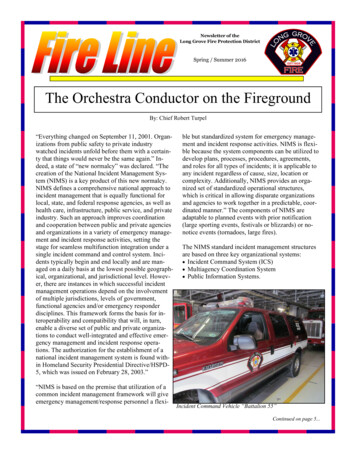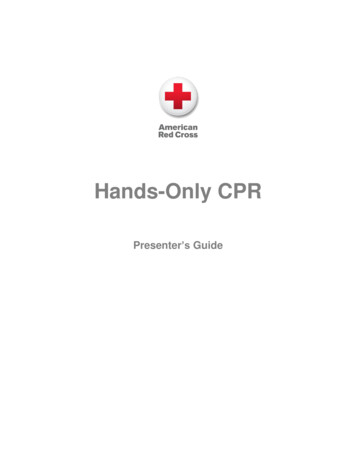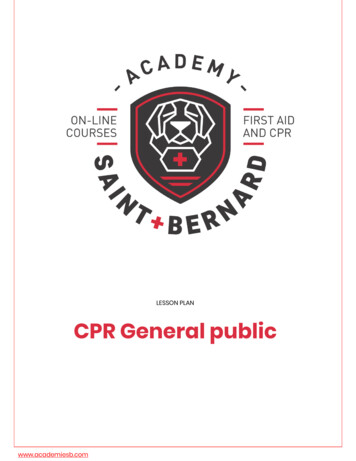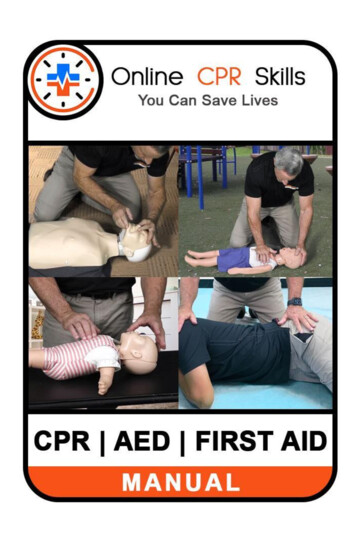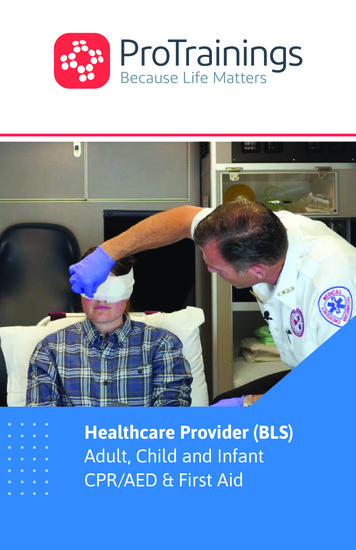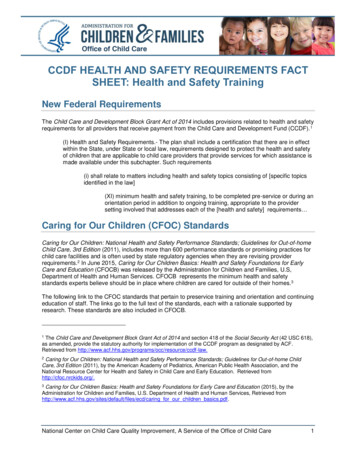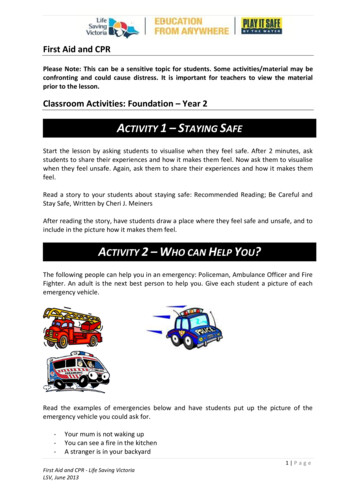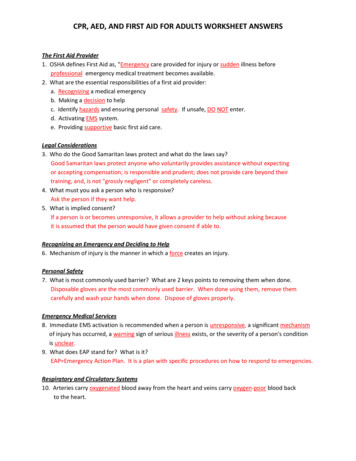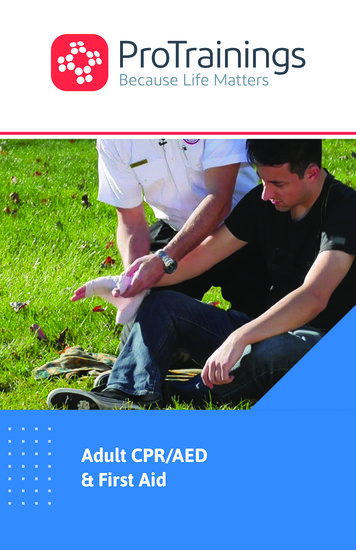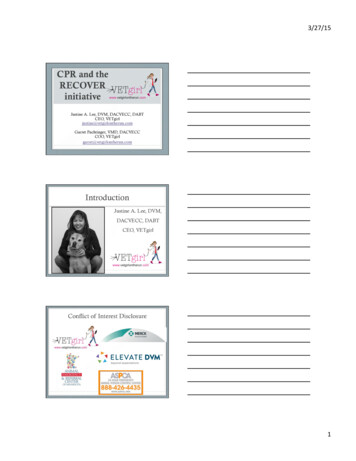
Transcription
3/27/15'CPR and theRECOVERinitiativeJustine A. Lee, DVM, DACVECC, DABTCEO, VETgirljustine@vetgirlontherun.comGarret Pachtinger, VMD, DACVECCCOO, ne A. Lee, DVM,DACVECC, DABTCEO, VETgirlConflict of Interest Disclosure1'
3/27/15'IntroductionGarret Pachtinger,VMD, DACVECCCOO, VETgirlAssociate, VSECVETgirl On-The-Run The tech-savvy way to get CE credit! A subscription-based podcast & webinar serviceoffering veterinary RACE-approved, online CESubscription Plans VETgirl Standard: 50-60 podcasts/year 99/year 4 hours of RACE-CE VETgirl ELITE: 50-60 podcasts/year plus 20hours of webinars! 199/year 20 hours of RACE-CE2'
3/27/15'Members: iTunes Download!Find us on social media and our blog!Logistics: CE nar'Ac9ve'par9cipa9on' ! ns'! garret@vetgirlontherun.com'! jus9ne@vetgirlontherun.com'3'
3/27/15'Call in from Smart Phone!Goals Getting a code survival Definition of CPA Advanced life support Class of drugs Defibrillation Chemical support Patient assessment ABCs of CPR Airway Breathing Circulation Prolonged life support arrhythmias compressionsCPR in veterinary medicine Overall studies: Dogs: 25% survival Cats: 22% Haskins and Kass 1992: 1 week survival rates 4% (both dogs and cats) Wingfield 1992: 4.1% dogs, 9.6% cats Human medicine: 21 and 29% survival4'
3/27/15'Cardiopulmonary arrest (CPA) CPA: the abrupt, unexpected cessation ofspontaneous and effective ventilation andcirculation CPCR/CRP: cardiopulmonary cerebralresuscitation: the provision of artificialventilation and perfusion until advanced lifesupport can be provided Basic life support Advanced life support Prolonged life support5'
3/27/15'ABC s of Basic Life Support A airway B breathing C circulation Or is it?Reassessment Campaign on VeterinaryResuscitation (RECOVER)1. Preventative measures andPreparedness2. Basic Life Support3. Advanced life support4. Monitoring5. Post-cardiac arrest careReassessment Campaign on VeterinaryResuscitation (RECOVER)1. Preventative measures andPreparedness2. Basic Life Support3. Advanced life support4. Monitoring5. Post-cardiac arrest care6'
3/27/15'CPR Poor Prognosis Overall poor prognosis 4.1% survival rate for dogs 9.6% survival rate for cats Humans veterinary Etiology important Anesthesia related other Respiratory full CPA Until now guidelines were derived fromhumansPearl 1: They’re already dead Pearl 2: Get a code7'
3/27/15'WHAT TO SAY TO THE OWNER Red code/DNR Yellow code (e.g., closed chest CPR) full resuscitation that stops short of internal cardiacmassage Green code (e.g., open chest CPR) full resuscitation with internal cardiac massage, ventilatorsupport Pearl 3:Preparation not perspiration . Essential for efficient CPR Problems: Missing equipment Unable to identify/find drugs Equipment failure Most often human error Solutions: Educate, train, plan Standardize crash carts Regularly stock crash cartsPRE-STOCKED ARREST STATIONMonitoring equipmentDefibrillatorEndotracheal tubes/laryngoscopeSuction and othercatheters etcPrepared crashdrugsOther drugs8'
3/27/15'Other Ways to Improve CPR Efforts CPR Workshops / Lectures in practice Post-CPR debriefing Standardized training programs Use of manikins / devicesPearl 4: Better CPR Candidates? Anesthetic events Neonates Arrests in hospital presents DOA Trauma SEPSIS / SIRS / MODSPearl 5:It’s a good thing you’re here 9'
3/27/15'Reassessment Campaign on VeterinaryResuscitation (RECOVER)1. Preventative measures andPreparedness2. Basic Life Support3. Advanced life support4. Monitoring5. Post-cardiac arrest careWhy do our patients arrest? Most common arrest rhythm pulseless electricalactivity Asystole Ventricular fibrillation Sinus bradycardiaPatient assessment10'
3/27/15'Diagnosis of arrest: Absence of a palpable pulse ( 60 mmHg) Absence of heart sounds ( 50 mmHg) Dilation of pupils Agonal breathingWarning signs of CPA Weak, irregular pulses Bradycardia or severe tachycardia Changes in respiratory rate, effort, orpattern Cyanosis Hypothermia HypotensionBasic Life Support (BLS) Proper technique and timingessential Any delay leads to a worseprognosis Successful outcome whenwell prepared Quick assessment,recognition andintervention11'
3/27/15'Disco Saves Lives“Stayin’ Alive”Basic Life Support: Airway ABC’s Do not delay chestcompressions in order tointubate !Recommended tointubate in lateral recumbency Maybe difficult to intubate Laryngoscope, stylet Suction if necessary Direct palpation if necessaryBasic Life Support: Airway Inflate the cuff and secure the tube Check placement Visualize, palpate, auscult, chest wallmovement End-tidal CO2 always higher intrachea vs. esophagus Problems (can’t hear lungs/chest notmoving) Severe pleural space/parenchymaldisease12'
3/27/15'Basic Life Support: Breathing Manually ventilate with100% oxygen Ambu-bag, anesthesiamachine (be sure to flushsystem if inhalant gas on)!Basic Life Support: Breathing Manually ventilate with 100%oxygen Ambu-bag, anesthesia machine(be sure to flush system if inhalantgas on) 10 bpm Inspiratory time of 1 sec and atidal volume of 10 ml/kg Avoid excessive ventilation!!Excessive ventilation ratesIncreased intrathoracic pressureDecreased coronary perfusionDecreased cerebral perfusionDecreased survival13'
3/27/15'Basic Life Support: Ventilation Mouth to snout No studies, just a case report May effectively oxygenate andventilate Hold patients mouth tightlyclosed, place mouth over naresmaking a tight seal, and givesome breaths Suggested C/V ratio is 30:2Basic Life Support:Circulation Best external compressions can only generate25% of normal cardiac output Perform GOOD CHEST COMPRESSIONS! Two theories Cardiac pump model for small animals Thoracic pump model for large animalsCirculation Closed chest CPR (CC CPR)Cardiac pump theory For cats (one hand) For dogs 15 kgs (right lateral) Artificial systole via chest compression compresses theV A resulting in closure of the AV value14'
3/27/15'Cardiac pump theory Artificial systole via chest compressioncompresses the V A resulting in closure of the AVvalue Causes ejection of blood into the systemic arteries During chest relaxation or diastole, intracardiacpressure falls and V A pressure, resulting in openingof AV valves and ventricular fillingThoracic pump theory For dogs 15 kgs Right lateral Widest part of the chest No direct heart compressionThoracic pump theory No direct heart compression Theory: blood flow generated by externalthoracic compression is the result of an increasein intrathoracic pressure15'
3/27/15'Thoracic pump theory The majority of blood flow results from anincrease in intrathoracic pressure and notdirectly from cardiac compression! Compress over the widest part of the chest 60-100 bpm Increase amount of compression force anddisplacementBasic Life Support:Circulation For cats and small dogs Perform chestcompressions directlyover the heartBasic Life Support:Circulation For large dogs Compress over the widestpart of the thorax Stack hands, compresswith the palms16'
3/27/15'Basic Life Support:Circulation Barrel-chested breeds Dorsal recumbency Hands directly over theheartBasic Life Support: Circulation Compression rate should be AT LEAST100-120 per minute, if not higher Deep compressions important Compress the width of the chest by1/3-1/2 Allow for full recoil! Blood needs to flowback Don’t lean Stand behind the animal (spine towardsyou) and from above (use a stool ifnecessary)Basic Life Support:Circulation Don’t ask - just change compressors every 2 mins – avoidfatigue Minimize interruptions of chest compressions to less than10 secs every 2 mins Evaluate the ECG no more frequently than every 2 mins17'
3/27/15'Basic Life Support: Circulation Interposed Abdominal Compression Abdomen is compressed duringrelaxation phase of chest compressionReassessment Campaign on VeterinaryResuscitation (RECOVER)1. Preventative measures andPreparedness2. Basic Life Support3. Advanced life support4. Monitoring5. Post-cardiac arrest careAdvanced: ResQPOD Selectively impedes inspiratory gases during therelease phase of CPR, resulting in: Increased negative pressure in the chestGreater venous return to the heartIncreased coronary perfusionIncreased blood flow during the next compression18'
3/27/15'Open Chest CPR Can achieve 100% cardiac output Allows for cross clamping of aorta Indications: Significant pleural space diseaseChest wall diseasePericardial effusionIntra-operative arrestsHemoabdomenLarge dogsUnsuccessful closed chest CPR (after 5 mins)Open Chest CPR Disadvantages Need experienced team Need surgical back-up Financial responsibility Risk of infectionOpen Chest CPR - Technique"5thor 6th ICS on left or right side" Left side preferred" Clip strip of hair over incision site" Quick prep with antiseptic solution - remove hair and dirt" Incise with scalpel - avoid intercostal vessels" Extend with scissors - avoid internal thoracic artery" Spread ribs" Remove heart from pericardium - avoid vagus/phrenic nerves" Compress heart with flat of fingers & palm" Keep heart in natural position during compressions" Can cross clamp aorta# 10 minutes, release slowly19'
3/27/15'Open Chest CPRComponents of CPR Advanced Life Support Electrocardiogram Drug therapy Defibrillation Post-Resuscitation CareEstablishing Access for Drugs Venous access Central peripheral If peripheral, place in forelimbs hindlimbs Lots of flush! Immediate surgical cutdown often necessary20'
3/27/15'Establishing Access for DrugsEstablishing Access for Drugs Intraosseous access (IO) if unable to obtainvenous access Femur, humerus, tibia Hypodermic, spinal, or intraosseus needle Contraindicated in fractured boneIntraosseous Catheter Placement21'
3/27/15'Establishing Access for Drugs Intratracheal administration (IT) Double dose (at least), dilute to 2-5 ml, red rubber, noNaHCO3 or calcium Intracardiac administration not recommended!ABC.Drugs - route Route Intra-cardiac?Vasopressors (Epinephrine, Vasopressin)Increase vascular resistanceIncrease aortic blood pressureIncrease myocardial and cerebral perfusion pressuresIncrease blood flow to heart and brainMyocardial Perfusion Pressure Aortic diastolic pressure – Right atrial pressureCerebral Perfusion Pressure Mean arterial (aortic) pressure – Intracranial pressure22'
3/27/15'EPINEPHRINE Potent andcatecholamine receptor agonistadrenergic effects importantadrenergic effects detrimentalDoses: Low dose – 0.01-0.02 mg/kgHigh dose – 0.1-0.2 mg/kg High dose associated with worse neurological outcomesand survivalEPINEPHRINE Low dose recommended early q. 3-5mins but high dose can be tried if nosuccess Alternate with vasopressin and giveevery other cycle of BLSAdvanced Cardiac Life support:Vasopressors Vasopressin Potent vasoconstrictor via direct V1 receptors invascular smooth muscle Unlike catecholamines, this response is not blunted inthe face of acidosis Doesn’t increase myocardial oxygen demand 0.8 u/kg IV23'
3/27/15'Advanced Cardiac Life support:Vagolytics Atropine Due to potential parasympathetic contribution toPEA or asystole, use a vagolytic! 0.04 mg/kg Once you give it, you can’t take it away! Treatment for vagal 1 cc: 20 lbsAdvanced Cardiac Life Support Sodium Bicarbonate: debated! Pros: Corrects the metabolic acidosis Cons: respiratory acidosis hyperosmolality transient hypotension hypernatremia hypokalemia hypocalcemia leftward shift in oxyhemoglobin curve paradoxical CNS acidosis Decreased in-hosp resuscitation ratesAdvanced Cardiac Life Sodium Bicarbonate: debated! Recommended in certain cases: Severe hyperkalemia CPCR 10 minutes Severe pre-existing metabolic acidosis Dose: 1 mEq/kg 1 ml/kg24'
3/27/15'Glucose When in doubt, don’t use it! Worsens head trauma Ischemic brain tissue - glucose metabolism to lacticacid - increased ischemic cellular damage Only use in the face of documented hypoglycemiaAdvanced Cardiac Life: IVF No longer the mainstay therapy! Increases carotid blood flow, BP Aortic diastolic pressure – RA diastolic pressure coronary perfusion pressure To increase coronary perfusion pressure, the gradient btwthe two diastolic pressures must increase B/C IVF increases RA pressure, it decreases coronaryand cerebral circulation.Intravenous Fluids Only indicated in hypovolemia to restore bloodvolume Increases central venous pressure (right atrialpressure) in the euvolemic or hypervolemic patient– opposing coronary perfusion Myocardial perfusion pressure Aortic diastolicpressure –right atrial pressure (RAP)25'
3/27/15'Defibrillation Only effective method for conversion of Vfib & pulseless Vtach Delivery of an electrical shock that depolarizes all myocardialcells Time between onset & defibrillation inversely associated withsurvival Monophasic & biphasic defibrillators, biphasic preferredDEFIBRILLATION Ideally lateral recumbency for safety Be aware of metal Use enough contact gel Confirm ventricular fibrillation Confirm current Halt ongoing CPRDEFIBRILLATION Call Clear Confirm that all personnel are clear Deliver current Immediate follow with 2 mins of BLS Do not stop to re-evaluate ECG for 2mins26'
3/27/15'Defibrillation Initial shock Monophasic: 4-6 J/kg externally, 0.4-0.6 J/kginternally Biphasic: 2-4 J/kg externally, 0.2-0.4 J/kg internally BLS before defibrillation? If 4 mins, immediately shock If 4mins, give one cycle of BLS then shockDefibrillation Consecutive shocks not recommended Follow with immediate chest compressions andventilation for 2 mins If the initial shock is not successful, increase theenergy by 50%Anesthesia-Related Arrests Not common Better prognosis Turn off inhalant and flush system REVERSAL AGENTS Naloxone – reverse opioids, 0.01-0.04 mg/kg Flumazenil – reverse benzodiazepines, 0.01-0.04 mg/kg Yohimbine/atipamezole – reverse alpha2 agonists, give samedose slowly IV Open chest CPR should be performed if thoracotomy orceliotomy occurring27'
3/27/15'Reassessment Campaign on VeterinaryResuscitation (RECOVER)1. Preventative measures andPreparedness2. Basic Life Support3. Advanced life support4. Monitoring5. Post cardiac arrest careMonitoring CPR Efforts ECG Palpate pulses May be misleading (venous pulses, pulse pressure) Remember to not interrupt BLSMonitoring CPR Efforts End-tidal CO2 Excellent monitoring tool for CPR Higher ETCO2 correlates with improved bloodflow to lungs (and improved cardiac output) Marked increase in ETCO2 during CPR oftenindicates ROSC Valuable for verifying ET tube placement butuse other skills28'
3/27/15'CapnogramExpirationInspiration I Inspiratory baseline Fresh gas containing no CO2 passing through analyse II Expiratory upstroke Begin of exhalation Dead space elimination from respiratory tract CO2 concentration is increasing as alveolar air is reaching analyse III Expiratory plateau Exhalation of pure alveolar gas O Inspiratory downstroke Start of inhalation Fresh gas “washing away” CO2 of gases from previous exhalationCapnography Summary Normal ETCO2 35 – 45 mmHg High ETCO2 ( 55mmHg) Hypoventilation Low ETCO2 Low, abnormally high / normal PaCO2Capnography Summary Normal capnogram is a “square wave” Sudden changes in ETCO2 and in the waveformmay be due to problems with Patient ETT Breathing circuit Sampling system29'
3/27/15'Reassessment Campaign on VeterinaryResuscitation (RECOVER)1. Preventative measures andPreparedness2. Basic Life Support3. Advanced life support4. Monitoring5. Post cardiac arrest careProlonged Life Support Recurrence of arrest within 4 hours Cerebral resuscitation Low flow states during CPCR ischemia and hypoxia cerebraledema Treat as a head trauma Reperfusion injuryProlonged Life Support Reperfusion injury Cerebral ischemia calcium shifts brain tissue lacticacidosis increases in: Brain free acids Osmolality Extracellular excitatory amino acids Reoxygenation injury30'
3/27/15'Post-resuscitation cerebral injury Perfusion failure inadequate oxygen delivery Reoxygenation chemical cascades to cerebral necrosis Extracerebral derangements intoxication from postanoxia viscera Blood derangements due to stasis31'
3/27/15'Post-Resuscitation Care Optimize hemodynamic status Ensure adequate oxygen delivery using fluids,pressors, and pRBCs as needed Monitor BP, ECG/HR Early goal directed therapyPost-Resuscitation Care Control of respiratory function Maintain normocapnia and normoxemia Cerebrovascular reactivity to CO2 maintained Hypocapnia %PaCO2 – cerebral hypoxia Hypercapnia &PaCO2 – increased ICP Hypoxemia %PaO2 Hyperoxemia &PaO2 – reactive oxygen species O2 therapy: PaO2 80, SPO2 94% PPV: PaO2 80 with FIO2 0.6 or PaCO2 60despite tx, or severe fatigueProlonged Life Support Oxygen therapy (mask, nasal canula, PPV) 15-30 head tilt No jugular pressure (ICP)32'
3/27/15'Prolonged Life Support Inotropic support (dobutamine/dopamine) Anti-arrhythmic drugs (lidocaine) cECG monitoring, pulse oximetry, blood pressureProlonged Life Support Treatment for cerebral edema Mannitol Lasix Monitoring UOP (1-2 ml/kg/hour) Fluid therapy Antibiotic therapy Bacterial translocation gut No big guns!Post-Resuscitation Care Mild hypothermia For those who remain comatose only if PPV & advancedcritical care available No steroids! Hyperosmotic therapy (mannitol, hypertonic saline) For those with signs associated with cerebral edema (eg,comatose, abnormal mentation, etc) Referral of critically ill for PCA care to specialtyhospital is recommended33'
.com'This material is copyrighted by VetGirl, LLC. None of the materials provided may beused, reproduced or transmitted, in whole or in part, in any form or by any means,electronic or otherwise, including photocopying, recording or the use of any informationstorage and retrieval system, without the consent of VetGirl, LLC. Unless expressly statedotherwise, the findings, interpretations and conclusions expressed do not necessarilyrepresent the views of VetGirl, LLC. Medical information here should be references bythe practitioner prior to use. Under no circumstances shall VetGirl, LLC. be liable for anyloss, damage, liability or expense incurred or suffered that is claimed to have resulted fromthe use of the information provided including, without limitation, any fault, error,omission, interruption or delay with respect thereto. If you have any questions regardingthe information provided, please contact info@vetgirlontherun.com34'
3/27/15'Check out our 2015 upcoming VETgirlappearances!Dr. Justine Lee International Veterinary Seminars(IVS), Kiwah Island, April 2015 Merck, NYC, April 2015 IVS, Vancouver, June 2015 IVS, Amelia Island, July 2015Dr. Garret Pachtinger CVC Washington D.C, April 2015 Hills Global Symposium, Miami,April 201535'
ABC s of Basic Life Support A airway B breathing C circulation Or is it? Reassessment Campaign on Veterinary Resuscitation (RECOVER) 1. Preventative measures and Preparedness 2. Basic Life Support 3. Advanced life support 4. Monitoring 5. Pos

